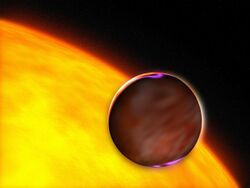Astronomy:XO-1
| Observation data Equinox J2000.0]] (ICRS) | |
|---|---|
| Constellation | Corona Borealis[1] |
| Right ascension | 16h 02m 11.8462s[2] |
| Declination | +28° 10′ 10.420″[2] |
| Apparent magnitude (V) | 11.19 ± 0.03[3] |
| Characteristics | |
| Spectral type | G1V[3] |
| Apparent magnitude (B) | 11.85 ± 0.04[3] |
| Apparent magnitude (V) | 11.19 ± 0.03[3] |
| Apparent magnitude (J) | 9.939 ± 0.022[4] |
| Apparent magnitude (H) | 9.601 ± 0.017[4] |
| Apparent magnitude (K) | 9.527 ± 0.015[4] |
| Variable type | Planetary transit variable[3] |
| Astrometry | |
| Proper motion (μ) | RA: −17.349(12)[2] mas/yr Dec.: 14.780(15)[2] mas/yr |
| Parallax (π) | 6.1489 ± 0.0136[2] mas |
| Distance | 530 ± 1 ly (162.6 ± 0.4 pc) |
| Absolute magnitude (MV) | 5.02+0.14−0.16[5] |
| Details | |
| Mass | 1.027+0.057−0.061[5] M☉ |
| Radius | 0.94 ± 0.02[6] R☉ |
| Luminosity | 0.86+0.12−0.10[5] L☉ |
| Surface gravity (log g) | 4.50 ± 0.01[7] cgs |
| Temperature | 5738 ± 65[7] K |
| Metallicity [Fe/H] | −0.06 ± 0.07[7] dex |
| Rotational velocity (v sin i) | 1.1 ± 1.0[7] km/s |
| Age | 1.0+3.1−0.9[5] Gyr |
| Other designations | |
| Database references | |
| SIMBAD | data |
XO-1 is a magnitude 11 G-type main-sequence star located approximately 530 light-years away[2] in the constellation Corona Borealis. XO-1 has a mass and radius similar to the Sun. In 2006 the extrasolar planet XO-1b was discovered orbiting XO-1 by the transit method using the XO Telescope.[3]
The star XO-1 is named Moldoveanu. The name was selected in the NameExoWorlds campaign by Romania, during the 100th anniversary of the IAU. Moldoveanu is the highest peak in Romania.[9][10][11]
Planetary system
The XO Project is an international team of professional and amateur astronomers which discovered the Jupiter-sized planet orbiting around XO-1. The team, led by Peter R. McCullough of the Space Telescope Science Institute in Baltimore, includes four amateur astronomers from North America and Europe. The planet was confirmed using the Harlan J. Smith Telescope and Hobby-Eberly Telescope at McDonald Observatory of the University of Texas.[3] An independent confirmation of the planet was made by the Wide Angle Search for Planets project.[12] In 2019, the planet was named Negoiu, after Negoiu Peak in Romania.
Further observations with the NICMOS instrument on board the Hubble Space Telescope detected the presence of water vapor, methane, and carbon dioxide in the atmosphere of XO-1b.[13] However an independent reinvestigation of the same data was unable to reproduce these results.[14]
| Companion (in order from star) |
Mass | Semimajor axis (AU) |
Orbital period (days) |
Eccentricity | Inclination | Radius |
|---|---|---|---|---|---|---|
| b / Negoiu | 0.907±0.022 MJ | 0.04914±0.00045 | 3.94150514(20) | <0.019 | 88.84±0.22° | 1.199±0.017 RJ |
See also
- List of transiting extrasolar planets
References
- ↑ Roman, Nancy G. (1987). "Identification of a Constellation From a Position". Publications of the Astronomical Society of the Pacific 99 (617): 695–699. doi:10.1086/132034. Bibcode: 1987PASP...99..695R. Vizier query form
- ↑ 2.0 2.1 2.2 2.3 2.4 Vallenari, A. et al. (2022). "Gaia Data Release 3. Summary of the content and survey properties". Astronomy & Astrophysics. doi:10.1051/0004-6361/202243940 Gaia DR3 record for this source at VizieR.
- ↑ 3.0 3.1 3.2 3.3 3.4 3.5 3.6 McCullough, P. R. et al. (2006). "A Transiting Planet of a Sun-like Star". The Astrophysical Journal 648 (2): 1228–1238. doi:10.1086/505651. Bibcode: 2006ApJ...648.1228M.
- ↑ 4.0 4.1 4.2 Skrutskie, Michael F. et al. (1 February 2006). "The Two Micron All Sky Survey (2MASS)". The Astronomical Journal 131 (2): 1163–1183. doi:10.1086/498708. ISSN 0004-6256. Bibcode: 2006AJ....131.1163S. Vizier catalog entry
- ↑ 5.0 5.1 5.2 5.3 Torres, Guillermo et al. (2008). "Improved Parameters for Extrasolar Transiting Planets". The Astrophysical Journal 677 (2): 1324–1342. doi:10.1086/529429. Bibcode: 2008ApJ...677.1324T.
- ↑ Burke, Christopher J. et al. (2010). "NICMOS Observations of the Transiting Hot Jupiter XO-1b". The Astrophysical Journal 719 (2): 1796–1806. doi:10.1088/0004-637X/719/2/1796. Bibcode: 2010ApJ...719.1796B.
- ↑ 7.0 7.1 7.2 7.3 Torres, Guillermo et al. (2012). "Improved Spectroscopic Parameters for Transiting Planet Hosts". The Astrophysical Journal 757 (2): 161. doi:10.1088/0004-637X/757/2/161. Bibcode: 2012ApJ...757..161T.
- ↑ "TYC 2041-1657-1". SIMBAD. Centre de données astronomiques de Strasbourg. http://simbad.u-strasbg.fr/simbad/sim-basic?Ident=TYC+2041-1657-1.
- ↑ "Romania | NameExoworlds". http://www.nameexoworlds.iau.org/romania.
- ↑ "Approved names" (in en). http://www.nameexoworlds.iau.org/final-results.
- ↑ "International Astronomical Union | IAU". https://www.iau.org/news/pressreleases/detail/iau1912/.
- ↑ Wilson, D. M. et al. (2006). "SuperWASP Observations of the Transiting Extrasolar Planet XO-1b". The Publications of the Astronomical Society of the Pacific 118 (847): 1245–1251. doi:10.1086/507957. Bibcode: 2006PASP..118.1245W.
- ↑ Tinetti, G. et al. (2010). "Probing the Terminator Region Atmosphere of the Hot-Jupiter XO-1b with Transmission Spectroscopy". The Astrophysical Journal Letters 712 (2): L139–L142. doi:10.1088/2041-8205/712/2/L139. Bibcode: 2010ApJ...712L.139T.
- ↑ Gibson, N. P. et al. (2011). "A new look at NICMOS transmission spectroscopy of HD 189733, GJ-436 and XO-1: no conclusive evidence for molecular features". Monthly Notices of the Royal Astronomical Society 411 (4): 2199–2213. doi:10.1111/j.1365-2966.2010.17837.x. Bibcode: 2011MNRAS.411.2199G.
- ↑ Bonomo, A. S. et al. (2017). "The GAPS Programme with HARPS-N at TNG . XIV. Investigating giant planet migration history via improved eccentricity and mass determination for 231 transiting planets". Astronomy and Astrophysics 602. doi:10.1051/0004-6361/201629882. Bibcode: 2017A&A...602A.107B. https://www.aanda.org/articles/aa/full_html/2017/06/aa29882-16/aa29882-16.html.
- ↑ Southworth, John et al. (2018). "Physical properties and optical-infrared transmission spectrum of the giant planet XO-1 b". Monthly Notices of the Royal Astronomical Society 481 (3): 4261–4276. doi:10.1093/mnras/sty2488. Bibcode: 2018MNRAS.481.4261S.
External links
- SpaceDaily: Astronomers Catch Planet By Unusual Means (May 19, 2006)
- "XO-1". Exoplanets. http://media4.obspm.fr/exoplanets/base/etoile.php?nom=XO-1.
Coordinates: ![]() 16h 02m 12s, +28° 10′ 11″
16h 02m 12s, +28° 10′ 11″
 |


